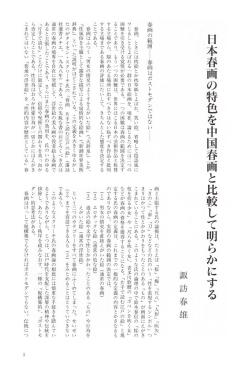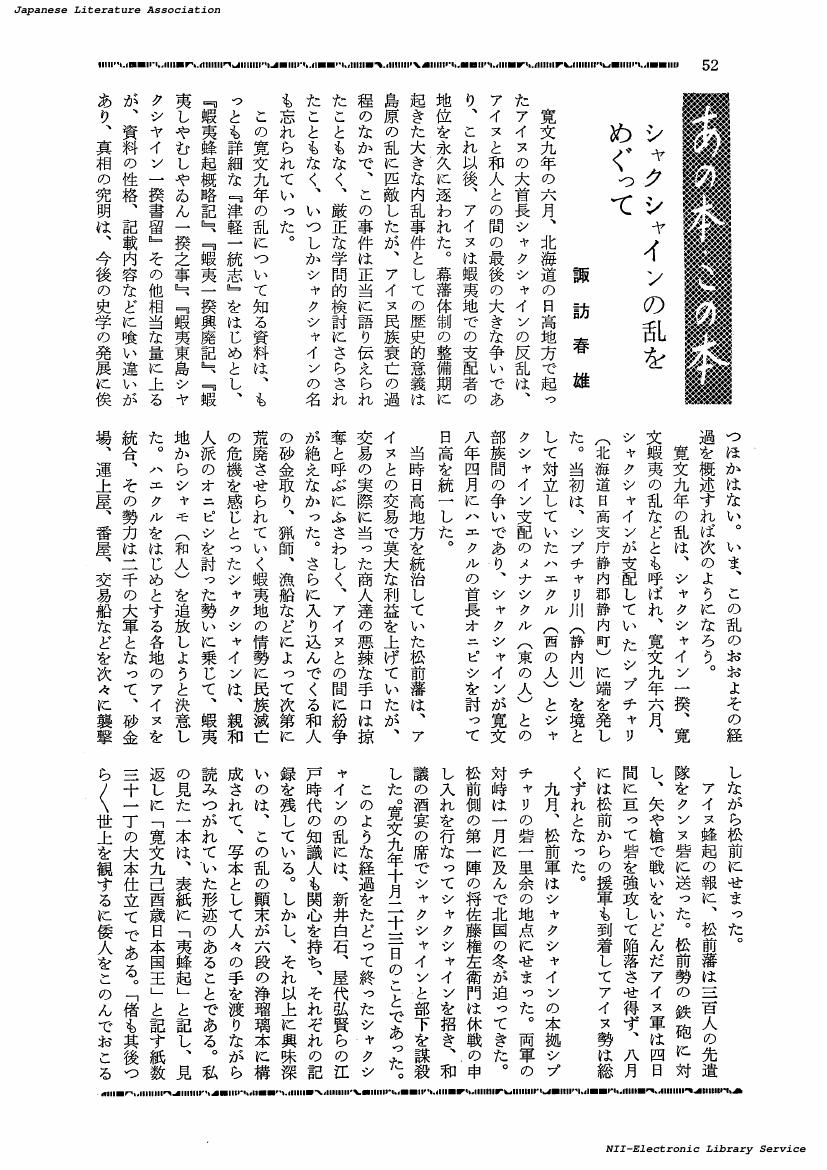6 0 0 0 OA 世界神話の二元構造の研究-善悪・生死・明暗
- 著者
- 篠田 知和基 吉田 敦彦 丸山 顕徳 松村 一男 中根 千絵 鈴木 正崇 不破 有理 服部 等作 山田 仁史 立川 武蔵 後藤 敏文 荻原 真子 木村 武史 後藤 明 廣田 律子 近藤 久美子 竹原 新 坂井 弘紀 諏訪 春雄 小松 和彦 鷹巣 純 栗原 成郎 依田 千百子
- 出版者
- 広島市立大学
- 雑誌
- 基盤研究(A)
- 巻号頁・発行日
- 2009-04-01
世界神話の基本的な二元構造を日本神話、ギリシャ神話、エジプト神話、インド・イラン神話、オセアニア神話、シベリア神話、アメリカ神話などにさぐった。明暗、水中の火、愛の二元性、罪と罰、異界と常世などのテーマでシンポジウムをおこない、それぞれの論文集を刊行した。生死、善悪の問題はそのつど検討された。最後は聖と穢れについて総括討論会をおこなった。その結果、世界神話は聖なるものを水中の火のような矛盾した概念のなかに追及するものであることがあきらかになった。
3 0 0 0 IR 仮名手本忠臣蔵と近世後期小説(赤穂事件に関する文芸と思想)
- 著者
- 諏訪 春雄
- 出版者
- 学習院大学
- 雑誌
- 調査研究報告 (ISSN:09196536)
- 巻号頁・発行日
- vol.18, pp.1-17, 1984-03
Theゴσγ癖(浄瑠璃ballad-drama)Kanαdehon C肋曲勿g%γα(仮名手本忠臣蔵), was first performed in 1748. It was a work comprised of and incorporating previously performed kabuki(歌舞伎)and jo"rzari based on the vengeance of the forty-sevenγσ%勿(浪人masterless samurai)of Ak6(赤穂),acastle town in Harima(播磨)province, and influenced in tu「n'the develoPment oM々σγδs乃∫9襯(赤穂浪士劇), or plays about the forty-sevenアδπ勿. Kanadehon C航s伽g%γαwas adapted for both励嘘ゴand%勿gyδshibai(人形芝居puppet theater). It also proved to be a favorite subject for novels, and was recast in the various literary modes that emerged in the Edo period, such as ukiyozoshi(浮世草子genre stories), yomihon(読本readers), sharebon(洒落本risqu6 stories), gokan(合巻 bound-together volumes), kibyo'shi(黄表紙"yellow-cover"picture booklets), kolekeibon(滑稽本humorous stories), and%吻励oπ(人情本human・interest stories). Representative examples of these various literary modes are examined in tracing the adaptive changes in Kanαdehon Chu-,shingura. To summarize, the purposes of this article are to compare these modes, includingゴσ剛γゴand kαbuki, for which Kanadehon Chu-shingurα was adapted, in order to elucidate the differences between the novelistic and dramatic renditions of this work;to distinguish the salient characteristics of the various literary modes which emerged in the latter half of the Edo period;and to show, by analyzing the complex pIot of Kanadehon C厩s痂π9%γα,・how thel national /character of the Japanese peoPle was popularly interpreted in the Edo period. A丘nal objective is to clarify「how the novelists of the time, who constituted an inte11ectual elite, and their readers conceptualized and interpreted the tale of the forty・sevenγσ7¢〃¢.
2 0 0 0 OA 中国江南の蛇信仰と日本 (アジアの祭りと芸能)
- 著者
- 諏訪 春雄
- 雑誌
- 調査研究報告 (ISSN:09196536)
- 巻号頁・発行日
- no.37, pp.22-36, 1992-03-01
上田秋成の名作『雨月物語』「蛇性の婬」の女主人公真名児は蛇の身でありながら、人間の男性に恋し、姿を変え、形を変えて付きまとうが、最後には紀伊国の道成寺の法海和尚の法力によって退治されてしまう。そこには蛇を忌避して、蛇と人間との恋愛など許されるはずもないとする仏教的な畜生観が反映している。このような蛇を忌避する思想はこの作の典拠となった中国明代の白話小説にもはっきりとあらわれており、秋成はその思想に共鳴して、自作に取り入れている。しかし、中国の江南地方には紀元三世紀のころまで呉、越の国が栄えており、ことに越の人々は蛇を祖神としてあがめていた。臼蛇と人間の若者との恋を主題とする白蛇伝や同じく蛇と人間との愛をあっかった蛇郎伝説などは、この越の人々によって生み出され、かれらによって中国全土にひろめられていった。それらの伝承の世界には知識人の手になる白話小説などには見られない蛇に対する崇拝の情がある。この江南の蛇信仰は呉、越の人々の日本移住とともに日本へも伝えられた可能性が強い。縄文から弥生にかけての時代に行われていた蛇巫は現在も江南の地に存在するし、中国の蛇郎伝説は日本の蛇婿入りの昔話となり、「蛇性の婬」に結晶した白蛇伝もかなり早い時期に中国から輸入され、昔話の世界で日本的に変容していたとみることができる。
2 0 0 0 IR 中国江南の蛇信仰と日本 (アジアの祭りと芸能)
- 著者
- 諏訪 春雄
- 出版者
- 学習院大学
- 雑誌
- 調査研究報告 (ISSN:09196536)
- 巻号頁・発行日
- vol.37, pp.22-36, 1992-03
上田秋成の名作『雨月物語』「蛇性の婬」の女主人公真名児は蛇の身でありながら、人間の男性に恋し、姿を変え、形を変えて付きまとうが、最後には紀伊国の道成寺の法海和尚の法力によって退治されてしまう。そこには蛇を忌避して、蛇と人間との恋愛など許されるはずもないとする仏教的な畜生観が反映している。このような蛇を忌避する思想はこの作の典拠となった中国明代の白話小説にもはっきりとあらわれており、秋成はその思想に共鳴して、自作に取り入れている。しかし、中国の江南地方には紀元三世紀のころまで呉、越の国が栄えており、ことに越の人々は蛇を祖神としてあがめていた。臼蛇と人間の若者との恋を主題とする白蛇伝や同じく蛇と人間との愛をあっかった蛇郎伝説などは、この越の人々によって生み出され、かれらによって中国全土にひろめられていった。それらの伝承の世界には知識人の手になる白話小説などには見られない蛇に対する崇拝の情がある。この江南の蛇信仰は呉、越の人々の日本移住とともに日本へも伝えられた可能性が強い。縄文から弥生にかけての時代に行われていた蛇巫は現在も江南の地に存在するし、中国の蛇郎伝説は日本の蛇婿入りの昔話となり、「蛇性の婬」に結晶した白蛇伝もかなり早い時期に中国から輸入され、昔話の世界で日本的に変容していたとみることができる。Manago, the heroine of"Jasei no in"in一塑亘,amasterpiece by Akinari Ueda, loves a human although she is a snake. She changes her appearance, follows the man and is finally exterminated by Houkai, who is a Buddhist priest of Dojoji Temple in Kii Province, The story reflectS the Buddhist idea that snakes should be hated and that love between snakes and humans should not be allowed, The idea that snakes should be hated is found in a novel in colloquial Chinese in the Ming dynasty which is a source of the stoly. Akinari sympathized with the idea and used the story in his novels. However, people in Yueh, which existed in the Chiangnan district in China until the 3rd century, together with the people form Wu, worshiped a snake as their God. Hakujaden(the story of the white snake), the theme of which is love between awhite snake and a human youth, and Jaroudensetsu(the legend of the snake), whose theme is also love between a snake and a human, were created and spread everywhere in China by the Yueh people. In such folk tales, we can find examples of snake worship, which cannot be seen in stories such as the novels in colloquial Chinese created by the intelligentsia. The snake worship in Chiangnan was probably introduced to Japan by Wu and Yueh immigrants. Snake shamanism, which was found from the Jomon Era to the Yayoi Era in Japan, still exists in the Changnan district. Jaroudensetsu in China tumed into Japanese folk tales. Hakujaden, which crystallized into"Jasei no in", was also introduced from China in early times and was turned into Japanese folk tales.上田秋成的名作《雨月物語》"蛇性之淫"中的女主人公眞名見原本是一條蛇,却愛懸上了人間的男性。其不噺地攣化形態,追随自己喜愛的男子,最後地被紀伊國道成寺的法海和尚制伏。此故事反映了佛教忌誰蛇、不允許入蛇相懇的畜生観。這種忌諦蛇的思想在中國明代的白話小説中也明顯地存在着,上田秋成與此思想有着共鳴,因此以明代白話小説爲藍本創作了此作品。但是,公元三世紀之前,中國江南地匪的呉、越爾國十分昌盛,尤其是越人將蛇作爲祖神來崇葬。崇舞蛇的越人1門創作出了以白蛇與年輕男子相慧爲主題的"白蛇傳"以及同様表現蛇與人相愛的"蛇郎"傳説等作品。這些傳説故事又由他椚傳播到了全國各地。在這檬的傳承世界中存在着一種封蛇的崇舞之情。這様的崇#之情,在知識分子創作的白話小説中是看不到的。江南的蛇信仰恨可能随着呉越人的移居日本而傳到日本各地。流行於縄文、彌生時代的蛇巫,今天的江南地[副乃然存在着。中國的"蛇郎"傳説傳到日本而攣成了"蛇婿"的昔話;孕育出"蛇性之淫"的白蛇傳也在相當早的時期從中國傳到了日本。総之,在昔話的世界中可以看到蛇信仰在日本愛化的形態。
2 0 0 0 OA 鶏の血 (学会創設二十周年記念特集)
- 著者
- 諏訪 春雄
- 雑誌
- 学習院女子短期大学国語国文学会国語国文学論集 (ISSN:02896753)
- 巻号頁・発行日
- no.20, pp.122-140, 1991-03-20
2 0 0 0 IR 日本人の空間意識 : 右回り・左回りと東西軸・南北軸
- 著者
- 諏訪 春雄
- 出版者
- 学習院大学
- 雑誌
- 人文 (ISSN:18817920)
- 巻号頁・発行日
- vol.1, pp.35-53, 2002-03-25
日本人の空間認識に顕著にみられる傾向として右回りがある。17世紀以降の江戸をえがいた屏風、地図の類の空間配置はすべて右回りであり、京都、大坂の地理案内書も右回りである。現在の日本の民俗にも多くの右回りの習慣をあげることができる。一方、右回りの習慣ほど顕著ではないが、日本人に左回りの習慣もある。 なぜ、日本人の民俗に右回りが有力なのか。そして、他方で、わざわざ左回りに固執する民俗があるのはなぜなのか。 佛教の教義では、右回りを尊重し、左回りを不吉としている。また、左を聖、右を俗とし、両者を補完しあう関係とかんがえる理論もある。そのほか、いくつかの説明がこれまでに提出されている。中国の古代には右回りを天、陽、男、君として尊重し、左回りを地、陰、女、臣下として、低くかんがえる思想があった。この中国古代思想は、天の北極星にたいする信仰にもとづき、子午線の回転によって、世の中の秩序が進行するという考えが根底にあった。こうした子午線つまり南北軸重視の思想が日本の民俗の右回り重視の慣習を生んだと見ることができる。さらに、日本人の場合には、もう一つ、太陽にたいする信仰に由来する東西軸重視の思想が、右回りの民俗を支えていることに注意しなければならない。日本の右回りの空間認識は天の信仰に由来する南北軸重視と、太陽の信仰に由来する東西軸重視の二つの思想にささえられているところに、その強みがあった。日本社会に左回りの民俗が部分的に存在するのは、中国の古代思想にあきらかなように、劣位の観念として、右回りを補完するものである。 中国の北方大帝国には天の信仰がさかんであり、南北軸重視の思想がゆきわたっていた。それにたいし、古代日本には、中国の南方少数民族におこなわれていた太陽信仰にもとつく東西軸重視の思想がさかんであった。東西軸重視は、天の信仰よりも古い信仰として、日本の現代にまでつづく民俗慣習の基本原理となっている。Space recognition of the Japanese is characterized by the right-handed, namely clockwise, rotation. From the early seventeenth century, the maps of Edo were generally drawn on the clockwise system, as were the maps of Kyoto and Osaka」n the present-day f61k customs of the Japanese, we can see many examples of the right-handed rotatlon. On the other hand, in the fblk customs of the Japanese, there are a few examples of the lefthanded rotation, Why, do we have both ways in Japan? In the ancient northern Chinese empires, people had faith in the heavens. Faith in the heavens attaches importance to the north-south axis. On the other hand, in the southern China people had faith in the sun. Faith in the sun attaches importance to the east-west axls. Both Chinese faiths influenced the Japanese's clockwise orientation. The Japanese's lefthanded rotation found in folk customs is complementary ln lts nature.
1 0 0 0 OA 日本春画の特色を中国春画と比較して明らかにする
- 著者
- 諏訪 春雄
- 出版者
- 国際浮世絵学会
- 雑誌
- 浮世絵芸術 (ISSN:00415979)
- 巻号頁・発行日
- vol.135, pp.3-11, 2000 (Released:2021-03-13)
1 0 0 0 日本春画の特色を中国春画と比較して明らかにする
- 著者
- 諏訪 春雄
- 出版者
- 国際浮世絵学会
- 雑誌
- 浮世絵芸術 (ISSN:00415979)
- 巻号頁・発行日
- vol.135, pp.3-11, 2000
1 0 0 0 OA シャクシャインの乱をめぐって(あの本・この本)
- 著者
- 諏訪 春雄
- 出版者
- 日本文学協会
- 雑誌
- 日本文学 (ISSN:03869903)
- 巻号頁・発行日
- vol.23, no.3, pp.52-53, 1974-03-10 (Released:2017-08-01)
1 0 0 0 OA 世界神話のコスモロジー
- 著者
- 篠田 知和基 松村 一男 丸山 顕徳 目崎 茂和 不破 有理 廣田 律子 服部 等作 荻原 真子 栗原 成郎 吉田 敦彦 諏訪 春雄 栗原 成郎 三原 幸久 中根 千絵 鷹巣 純 目崎 茂和 後藤 明 丸山 顕徳 依田 千百子 松村 一男 岡本 久美子 立川 武蔵 小松 和彦 百田 弥栄子 小南 一郎 鈴木 正崇 門田 真知子 蔵持 不三也 不破 有理 服部 等作 広田 律子 荻原 真子 木村 武史 宮本 正興 クネヒト ペトロ 水野 知昭 中堀 正洋
- 出版者
- 広島市立大学
- 雑誌
- 基盤研究(A)
- 巻号頁・発行日
- 2005
「ユーラシアの神話の道」「海洋神話」につづき、主として天空の神話を世界神話においてしらべて比較し、そこから各文化の世界観、すなわちコスモロジーを究明した。天空神話としては日月、風、星辰、それに「天界」の神話をとりあげた。

